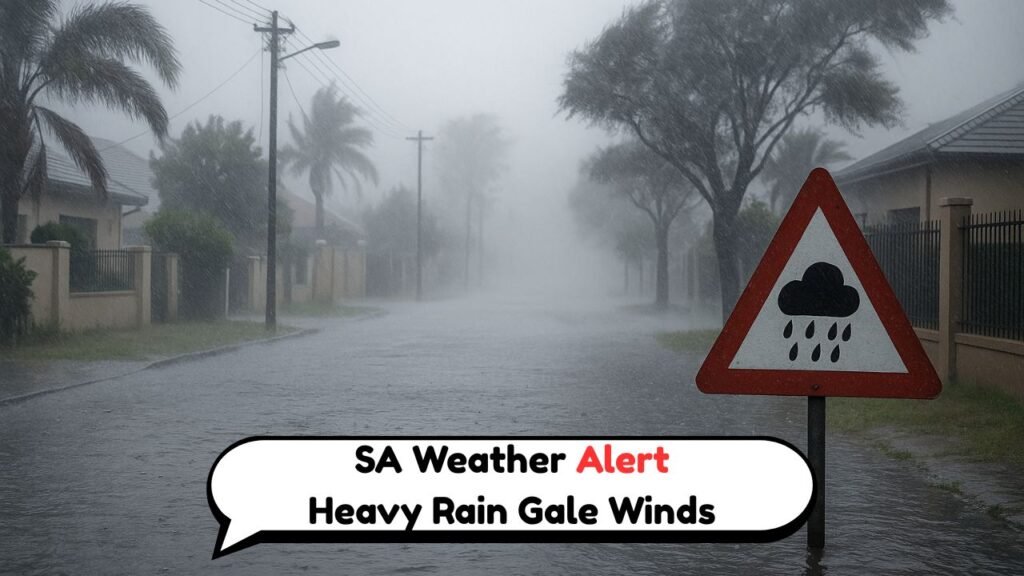South Africa Weather Warning – South Africa faces a disruptive spell of heavy rain and gale-force winds as a powerful cold front sweeps across the country. Forecasters warn of localized flooding, falling trees, hazardous surf, and reduced visibility, especially along coastal belts and mountain passes. Power disruptions and road closures are possible where saturated ground meets strong gusts. Residents are urged to secure loose items, check drainage, and avoid crossing fast-moving water. Fisherfolk and small craft should remain in harbour until conditions ease. Parents should plan around school transport delays, and motorists must drive with headlights on, increase following distances, and expect debris on routes.

Areas most at risk
The highest risk is expected along the southern and western coastline and adjacent ranges, where onshore flow funnels strong winds and heavy, persistent rain. Communities from the West Coast through the Cape Town Metro, Overberg and the Garden Route may face the earliest and most severe impacts, with slippery roads and storm-surge along exposed beaches. As the system tracks east, parts of the Eastern Cape, including Nelson Mandela Bay and the Wild Coast, could experience damaging gusts and downpours. Further north, high-lying districts of KwaZulu-Natal and sections of the Drakensberg may see disruptive snowfall mixed with rain, complicating mountain passes.
What conditions to expect
Expect widespread periods of moderate to heavy rain, peaking in squall lines that deliver short, intense bursts. Gale-force winds could exceed 60–70 km/h along the coast and in elevated terrain, with stronger gusts around storm fronts and headlands. Urban stormwater systems may struggle during high-tide cycles, increasing the risk of street flooding and backups into low-lying properties. Sea conditions will deteriorate rapidly, with rough to very rough seas, long-period swells, and treacherous rip currents. Thunder and small hail are possible inland where colder air undercuts moist surface layers, briefly reducing temperatures and creating wintry wind-chill. Stay alert for official warnings.
 Will the Government Respond? Millions Rally for Tax-Free SASSA Grants Amid Rising Public Outcry
Will the Government Respond? Millions Rally for Tax-Free SASSA Grants Amid Rising Public Outcry
Safety and travel advice
Delay non-essential travel during peak conditions, and check route closures before departing. If you must drive, reduce speed, use headlights, and allow extra stopping distance, especially near bridges, trees, and construction zones. Never attempt to cross flooded roads; even shallow, fast-moving water can sweep vehicles away. Pedestrians should avoid riverbanks, stormwater channels, and seawalls where waves may overtop without warning. Boaters, anglers, and beachgoers should remain ashore until swells subside. Keep mobile phones charged, stock torch batteries, and prepare a basic emergency kit with water, non-perishables, medications, warm clothing, and important documents sealed in waterproof bags through the next day.
How to prepare your home
Secure outdoor furniture, bins, satellite dishes, and signage to prevent windborne damage. Clear gutters, downpipes, and yard drains so water can flow away from buildings, and trim unstable branches threatening roofs, fences, or power lines. Park vehicles under cover and avoid low-lying car parks prone to pooling. Move valuables off floors, elevate electronics, and unplug non-essential appliances during lightning. Know how to manually open garage doors if power fails. Check neighbours who may need assistance, particularly the elderly. Keep pets indoors, store sandbags where flooding recurs, and review your household plan in case conditions worsen. Test sump pumps and alarms.


